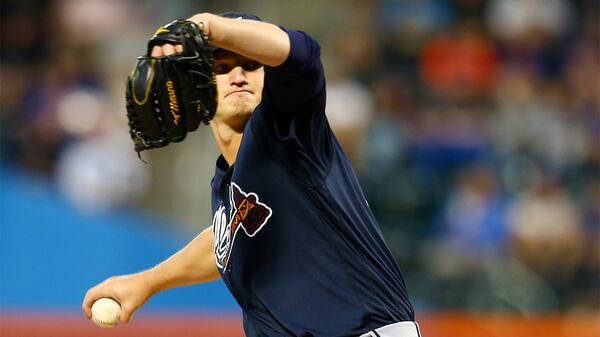“These are the days of miracle and wonder,” Paul Simon sang on the opening track of his greatest album. I’m not sure the first applies here: What’s miraculous about baseball’s best farm system producing impact players? But wondrous? Well … yeah.
The three youngest players in the majors are Braves. Ozzie Albies, who’s 5-foot-8, has nine home runs in 28 games. Through six big-league games, Ronald Acuna Jr. is hitting .417 with an OPS of 1.231. By now, those two youngsters seem old news. The latest headeline was written Tuesday night in Queens, where the 20-year-old Mike Soroka made his first MLB start against the first-place team in the National League East and the most fearsome starting pitcher in baseball. On cue, Soroka won.
He went six innings with one earned run, that coming on a sixth-inning homer by Yoenis Cespedes, who’s being paid $22.5 million this season to do such things. Soroka yielded six hits. He walked none. He struck out five, two more than Noah Syndergaard, known as Thor, did in his six innings. (Does that mean Soroka is Loki?) He needed 80 pitches. At one point he threw 27 strikes in 35 deliveries. His fastball touched 95 mph. His slider was biting. He was really good.
Soroka was staked to a three-run lead before taking the mound. Albies led off with a single. Acuna followed with a double. Freddie Freeman followed with another. Nick Markakis, reborn at age 34, drove in Freeman. The Braves wouldn’t score again. Didn’t need to. They won 3-2. They’re a half-game out of first place.
Soroka’s banner debut recalled another in that scenic borough. On July 23, 1988, a highly regard Braves prospect started against Bob Ojeda at Shea Stadium. The 21-year-old worked eight innings, yielding one run on four hits with two strikeouts and one walk. Gerald Perry and Dale Murphy had RBIs in the top of the first. The Braves won 6-1. The 21-year old was John Smoltz.
This isn’t to suggest that Soroka will be joining Smoltz in Cooperstown. (Little early for that, wouldn’t you say?) But if you’ve paid any attention to the Braves over the past three years, you shouldn’t have been overly surprised that he got here fast and looked terrific when he did. He was the 28th overall pick of the 2016 draft. He was the Braves’ second choice of Round 1; they’d taken Kolby Allard, another teenager, at No. 14. From their first turns in rookie ball, the Braves had gone back and forth as to which was the bigger talent. They decided not to decide and just love them both. They still do.
Credit: Mike Stobe
Credit: Mike Stobe
Soroka is as unfussy as any 20-year-old you’ll see. He has never walked many – 76 in 353-1/3 minor-league innings, this against 311 strikeouts. His minor-league WHIP (walks/hits per inning pitched) was 1.10, tremendous for a guy plucked straight from a Calgary high school. He did Tuesday what he’d been doing since turning professional. Difference was, he did it in the city that never sleeps and against a first-place club. Was it a surprise? Maybe a little, but only a little.
There’s a reason this farm system has, for three years running, been ranked as baseball’s best. There’s a reason Albies, Acuna and Soroka could be making big-league splashes at such tender ages. They were raised the right way. They weren’t rushed – Acuna’s advent was delayed by contractual considerations – and they were primed when summoned.
If you wondered why the Braves did all that selling and losing on purpose, the reason was to have more and better draft picks. Soroka is the first Braves draftee of the great rebuild to reach the majors, although Dansby Swanson was the 1-1 pick in the Soroka/Allard draft. The rebuild isn’t nearly finished, but John Coppolella – who’s no longer around, but whose work this mostly was – often described his vision of having “wave upon wave” of prospects. The first wave has well and truly arrived.
And the Braves are 17-11. After 28 games in 1991, the worst-to-first season, they were 16-12. We concede the parallels aren’t exact. The ’91 Braves had the 1990 rookie of the year in David Justice and a trio of terrific young pitchers – Tom Glavine, Steve Avery and the aforementioned Smoltz – but their great impetus came from offseason imports: Terry Pendleton, Sid Bream, Rafael Belliard, Otis Nixon. But that team, like this team, had a new general manager, John Schuerholz having arrived from K.C. in October 1990 to replace Bobby Cox, who’d returned to on-field managing. That team surprised us almost every day for six giddy months.
With one month gone, the 2018 Braves are doing something similar, albeit in a younger and bolder way. They’re grabbing us by the lapels and demanding that we pay attention. Because if we don’t, we might miss something cool.
Six days after Acuna’s ballyhooed arrival in Philly, Soroka trumped the god of thunder in the Big Apple. There’s a chance the Braves could leave New York in first place. There’s a chance we could soon see Allard and Kyle Wright and Austin Riley. On almost a daily basis, this team is doing wondrous things. If this continues, we might actually see that miracle.
About the Author


